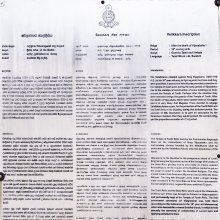Idam, Idaṃ: 11 definitions
Introduction:
Idam means something in Hinduism, Sanskrit, Buddhism, Pali, Hindi. If you want to know the exact meaning, history, etymology or English translation of this term then check out the descriptions on this page. Add your comment or reference to a book if you want to contribute to this summary article.
Images (photo gallery)
Languages of India and abroad
Pali-English dictionary
Source: BuddhaSasana: Concise Pali-English Dictionaryidaṃ : ((Nom. and Acc. sing. of ima) nt.) this thing.

Pali is the language of the Tipiṭaka, which is the sacred canon of Theravāda Buddhism and contains much of the Buddha’s speech. Closeley related to Sanskrit, both languages are used interchangeably between religions.
Sanskrit dictionary
Source: DDSA: The practical Sanskrit-English dictionaryIdam (इदम्).—pron. a. [ayam m., iyam f., idam n.]
1) This, here, referring to something near the speaker; इदमस्तु संनिकृष्टं रूपम् (idamastu saṃnikṛṣṭaṃ rūpam)); इदं तत् (idaṃ tat) ... इति यदुच्यते (iti yaducyate) Ś.5 here is the truth of the saying.
2) Present, seen; the nominative forms are used with verbs in the sense of 'here'; इयमस्मि (iyamasmi) here am I; so इमे स्मः (ime smaḥ); अयमागच्छामि (ayamāgacchāmi) here I come.
3) It often refers to something immediately following, while एतद् (etad) refers to what precedes; अनुकल्पस्त्वयं ज्ञेयः सदा सद्भिरनुष्ठितः (anukalpastvayaṃ jñeyaḥ sadā sadbhiranuṣṭhitaḥ) Manusmṛti 3.147 (ayam = vakṣyamāṇaḥ Kull.); श्रुत्त्वै- तदिदमूचुः (śruttvai- tadidamūcuḥ)
4) It occurs connected with यत्, तत्, एतद्, अदस्, किम् (yat, tat, etad, adas, kim) or a personal pronoun, either to point out anything more distinctly and emphatically, or sometimes pleonastically; कोऽयमाचरत्यविनयम् (ko'yamācaratyavinayam) Ś.1.25; सेयम्, सोऽयम् (seyam, so'yam), this here; so इमास्ताः (imāstāḥ); अयमहं भोः (ayamahaṃ bhoḥ) Ś.4 ho, here am I. -ind. Ved.
1) Here, to this place.
2) Now.
3) There.
4) With these words, herewith.
5) In this manner; नैतदौपयिकं राम यदिदं परितप्यसे (naitadaupayikaṃ rāma yadidaṃ paritapyase) Rām.2.53.3.
Source: Cologne Digital Sanskrit Dictionaries: Shabda-Sagara Sanskrit-English DictionaryIdam (इदम्).—pron. mfn.
(-ayaṃ-iyaṃ-idaṃ) This. E. ind to have power, kamin Unadi affix, and the radical na rejected.
Source: Cologne Digital Sanskrit Dictionaries: Benfey Sanskrit-English DictionaryIdam (इदम्).—[i + d-am], pron. sbst. and adj. The bases of the declension are a m. and n., ā f., i n. ī f., i-ma m. and n. i-mā f., a-na m. and n. a-nā f., and e-na m. and n. e-nā f. This, [Mānavadharmaśāstra] 2, 163; [Nala] 7, 17 (16). Combined with other pronouns it may be translated Here, e. g. with the first psn.,
— Cf. [Latin] is, ea, id; [Gothic.] is ita.
Source: Cologne Digital Sanskrit Dictionaries: Cappeller Sanskrit-English DictionaryIdam (इदम्).—([neuter] sgl. & °— as stem) this, this here (refers to something following, rarely preceding); this all or this universe (±viśvam, sarvam, or sakalam). Obs. also tadidam even this, this very thing, kimidam what here? As [adverb] here; now, thus, even, right. idamidam here and there, now and then.
Source: Cologne Digital Sanskrit Dictionaries: Monier-Williams Sanskrit-English Dictionary1) Idam (इदम्):—1 ayam, iyam, idam ([from] id, [Uṇādi-sūtra iv, 156]; [gana] sarvādi, [Pāṇini 1-1, 27; Vopadeva]; a kind of neut. of the [pronominal] base 3. i with am cf. [Latin] is, ea, id, and idem; the regular forms are partly derived from the [pronominal] base a; See [grammar] 224; the Veda exhibits various irregular formations e.g. [from] [pronominal] base a, an inst. enā, ayā [used in general adverbially], and [genitive case] [locative case] [dual number] ayos, and perhaps also avos, in [Ṛg-veda vi, 67, 11; vii, 67, 4; x, 132, 5] [Boehtlingk & Roth’s Sanskrit-Woerterbuch]; [from] the base ima, a [genitive case] [singular] imasya, only, [Ṛg-veda]; the [Ṛg-veda] has in a few instances the irregular accentuation asmai, [v, 39, 5, etc.]; asya, [iv, 15, 5, etc.]; ābhis, [vi, 25, 2, etc.] : the forms derived [from] a are used enclitically if they take the place of the third personal pronoun, do not stand at the beginning of a verse or period, and have no peculiar stress laid upon them), this, this here, referring to something near the speaker
2) known, present
3) (opposed to adas e.g. ayaṃ lokaḥ or idaṃ viśvam or idaṃ sarvam, this earthly world, this universe; ayam agniḥ, this fire which burns on the earth; but asāv agniḥ, that fire in the sky, id est. the lightning: so also idam or iyam alone sometimes signifies ‘this earth’; ime smaḥ, here we are.) idam often refers to something immediately following, whereas etad points to what precedes (e.g. śrutvaitad idam ūcuḥ, having heard that they said this). idam occurs connected with yad, tad, etad, kim, and a personal pronoun, partly to point out anything more distinctly and emphatically, partly pleonastically (e.g. tad idaṃ vākyam, this speech here following ; so yaṃ vidūṣakaḥ, this Vidūṣaka here).
4) 2. idam ind. ([Ved. and in a few instances in classical Sanskṛt]) here, to this place
5) now, even, just
6) there
7) with these words, [Ṛg-veda; Atharva-veda; Śatapatha-brāhmaṇa; Aitareya-brāhmaṇa; Chāndogya-upaniṣad]
8) in this manner, [Rāmāyaṇa ii, 53, 31; Śakuntalā] ([varia lectio] for iti in kim iti joṣam āsyate, [202, 8]).
Source: Cologne Digital Sanskrit Dictionaries: Yates Sanskrit-English DictionaryIdam (इदम्):—[(ayaṃ-iyaṃ-idaṃ) pron.] This.
Source: DDSA: Paia-sadda-mahannavo; a comprehensive Prakrit Hindi dictionary (S)Idam (इदम्) in the Sanskrit language is related to the Prakrit words: Ima, Īa, Ṇa.
[Sanskrit to German]
Sanskrit, also spelled संस्कृतम् (saṃskṛtam), is an ancient language of India commonly seen as the grandmother of the Indo-European language family (even English!). Closely allied with Prakrit and Pali, Sanskrit is more exhaustive in both grammar and terms and has the most extensive collection of literature in the world, greatly surpassing its sister-languages Greek and Latin.
Hindi dictionary
Source: DDSA: A practical Hindi-English dictionaryIdam (इदम्):—(pro) this;—[ittham] it is like this.
...
See also (Relevant definitions)
Starts with (+32): Idam Saccabhinivesa Kayagantha, Idama, Idambara, Idamdra, Idamdvitiya, Idamittha, Idamittham, Idamiya, Idamkarya, Idamkaryya, Idamkaya, Idamku, Idamkutodamku, Idammadhu, Idammadhura, Idammaya, Idampara, Idampati, Idampradhana, Idamprakaram.
Ends with (+435): A-vitam, Accuvatitam, Acitam, Agashidam, Akantitam, Akkantitam, Akkatitam, Akkirantitam, Akkitam, Alampalikitam, Alitam, Alvitam, Amalokitam, Amanitam, Amaridam, Amaritam, Amirakitam, Amirtamutuvitam, Amitam, Amparitam.
Full-text (+728): Ia, Aidamparya, Atra, Idamyu, Idamrupa, Idammadhu, Iyam, Yadidam, Itas, Ima, Idamkarya, Idriksha, Idamshabda, Idamprathama, Cyut, Ayam, Idanim, Ida, Ana, Yad.
Relevant text
Search found 164 books and stories containing Idam, Idaṃ, Idām; (plurals include: Idams, Idaṃs, Idāms). You can also click to the full overview containing English textual excerpts. Below are direct links for the most relevant articles:
The Practice Manual of Noble Tārā Kurukullā (by Dharmachakra Translation Committee)
Chapter 6 < [Appendix - Sanskrit Text]
Chapter 4 < [Appendix - Sanskrit Text]
Chapter 1 < [Appendix - Sanskrit Text]
Shrimad Bhagavad-gita (by Narayana Gosvami)
Verse 16.13 < [Chapter 16 - Daivāsura-sampada-yoga]
Verse 2.1 < [Chapter 2 - Sāṅkhya-yoga (Yoga through distinguishing the Soul from the Body)]
Verse 11.20 < [Chapter 11 - Viśvarūpa-darśana-yoga (beholding the Lord’s Universal Form)]
Bhajana-Rahasya (by Srila Bhaktivinoda Thakura Mahasaya)
Śrī Gaudīya Vaiṣṇavas’ Saṅkṣepa-arcana-paddhati
Text 12 < [Chapter 7 - Saptama-yāma-sādhana (Pradoṣa-kālīya-bhajana–vipralambha-prema)]
Text 3 < [Chapter 3 - Tṛtīya-yāma-sādhana (Pūrvāhna-kālīya-bhajana–niṣṭhā-bhajana)]
Rig Veda (translation and commentary) (by H. H. Wilson)
Brihad Bhagavatamrita (commentary) (by Śrī Śrīmad Bhaktivedānta Nārāyana Gosvāmī Mahārāja)
Verse 2.4.97 < [Chapter 4 - Vaikuṇṭha (the spiritual world)]
Verse 2.1.216 < [Chapter 1 - Vairāgya (renunciation)]
Verse 2.3.118 < [Chapter 3 - Bhajana (loving service)]
Garga Samhita (English) (by Danavir Goswami)
Verse 1.13.14 < [Chapter 13 - The Liberation of Pūtanā]
Verse 6.7.32 < [Chapter 7 - The Marriage of Śrī Rukmiṇī]
Verse 4.12.1 < [Chapter 12 - The Story of the Gopīs That In the Holi Festival Displayed Three Transcendental Virtues]


